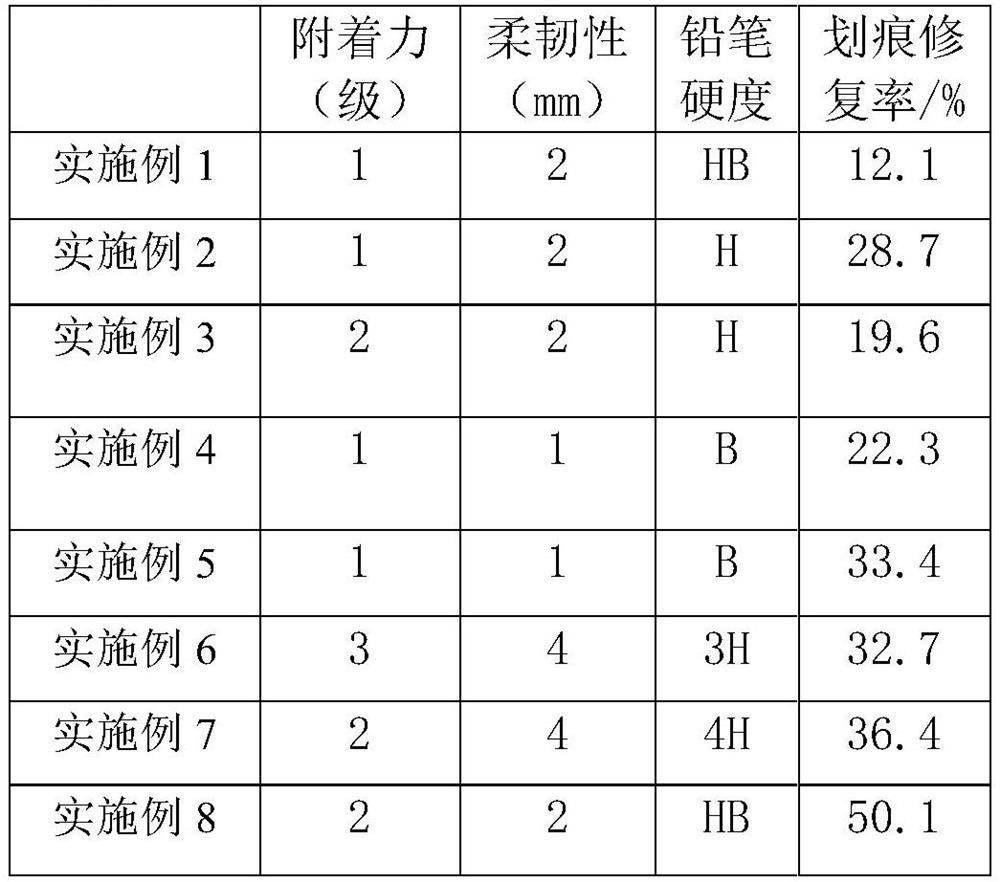Bio-based self-repairing photocureable coating as well as preparation method and application thereof
A light-curing coating and self-repairing technology, applied in the direction of coating, etc., can solve the problems of restricting the movement of chain segments, not being able to change the shape of materials, and reducing the ductility of materials, etc., to achieve simple synthesis, increase reusability, and increase system functional groups effect of density
- Summary
- Abstract
- Description
- Claims
- Application Information
AI Technical Summary
Problems solved by technology
Method used
Image
Examples
Embodiment 1
[0036] (1) First synthesize epoxidized vegetable oil: by weight in proportion: take 40 parts of soybean oil, 5 parts of formic acid and 50 parts of toluene, stir and preheat at 50 ° C for 30 minutes; add dropwise a total of 50 parts of hydrogen peroxide and 3 parts of concentrated sulfuric acid The mixture was heated to 70°C for 5 hours to obtain self-made epoxidized soybean oil.
[0037] (2) Epoxy soybean oil acrylate: in proportion by weight: Weigh 60 parts of epoxy soybean oil, 20 parts of acrylic acid, 3 parts of inhibitor hydroquinone and 2 parts of catalyst dibutyltin oxide at 50°C After stirring for 30 minutes, react at 100°C for 4 hours to obtain epoxy soybean oil acrylate.
[0038] (3) Stir and blend 40 parts of the above-mentioned epoxy soybean oil acrylate, 20 parts of methyl acrylate diluent, 5 parts of zinc acetylacetonate and 1 part of free radical photoinitiator benzoin dimethyl ether at room temperature for at least 30 minutes, 50 parts ℃ for at least 1 hour t...
Embodiment 2
[0040] (1) Synthesize epoxidized vegetable oil first: by weight in proportion: take 45 parts of rubber seed oil, 5 parts of formic acid and 50 parts of toluene, stir and preheat at 50°C for 30 minutes; add dropwise 50 parts of hydrogen peroxide and 3 parts of concentrated sulfuric acid The blend solution was heated to 70°C for 6 hours to obtain self-made epoxidized rubber seed oil.
[0041] (2) Synthetic epoxy rubber seed oil acrylate: in proportion by weight: weigh 60 parts of epoxy rubber seed oil, 20 parts of acrylic acid, 3 parts of polymerization inhibitor p-benzoquinone and 2 parts of catalyst triethylamine at 50°C After stirring for 30 minutes, react at 100°C for 4 hours to obtain epoxy rubber seed oil acrylate.
[0042] (3) Stir at room temperature with 50 parts of above-mentioned epoxy rubber seed oil acrylate, 20 parts of diluent hydroxypropyl acrylate, 6 parts of transesterification catalyst zinc acetylacetonate and 2 parts of free radical photoinitiator chlorinated...
Embodiment 3
[0044] (1) Synthesize epoxidized vegetable oil first: by weight in proportion: weigh 50 parts of tung oil, 5 parts of formic acid and 50 parts of toluene, stir and preheat at 50°C for 30 minutes; add dropwise a blend of 50 parts of hydrogen peroxide and 3 parts of concentrated sulfuric acid , heated to 70 ° C for 6 hours to obtain self-made epoxidized tung oil.
[0045] (2) Synthesis of epoxy tung oil acrylate: in proportion by weight: take 60 parts of epoxy tung oil, 20 parts of acrylic acid, 3 parts of polymerization inhibitor p-methoxyphenol and 2 parts of catalyst triphenylphosphine and stir at 110 ° C After 30 minutes, react at 100°C for 4 hours to obtain epoxy tung oil acrylate.
[0046] (3) 60 parts of above-mentioned epoxy tung oil acrylate, 20 parts of diluent hydroxypropyl methacrylate, 7 parts of transesterification catalyst 1,5,7-triazabicyclo[4.4.0]dec-5-ene Stir and blend with 3 parts of free radical photoinitiator D1173 at room temperature for at least 30 minut...
PUM
 Login to View More
Login to View More Abstract
Description
Claims
Application Information
 Login to View More
Login to View More - R&D
- Intellectual Property
- Life Sciences
- Materials
- Tech Scout
- Unparalleled Data Quality
- Higher Quality Content
- 60% Fewer Hallucinations
Browse by: Latest US Patents, China's latest patents, Technical Efficacy Thesaurus, Application Domain, Technology Topic, Popular Technical Reports.
© 2025 PatSnap. All rights reserved.Legal|Privacy policy|Modern Slavery Act Transparency Statement|Sitemap|About US| Contact US: help@patsnap.com


